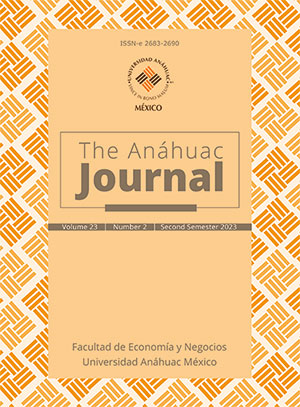Elasticities of VAT Collection and Mexican Imports: Analysis by subchapters in the period 2010-2022
Contenido principal del artículo
Resumen
This article obtained the elasticities of the Value Added Tax (VAT) collection with respect to merchandise imports classified in the 689 subchapters of the International Harmonized System 2010-2022. Evidence of an equilibrium relationship, in the long run, was found by cointegration in a VEC model. The results show that 65 subchapters explain 80% of the value of imports with different elasticities, which allows identifying the sensitivity of VAT collection in generating income from imports. The subchapters that stand out are plastic tubes and accessories, (elasticity 1.4622), devices for cutting or connecting electrical circuits (elasticity 1.3542), rubber and inflatable joints (elasticity 1.3513), electrical ignition devices and devices for motors (elasticity 1.3340) and plastic containers (elasticity 1.3173). Elasticities allow calculating increases in VAT collection due to movements in the value of imports, such as increases in VAT of US$ 212 million due to movements in the import of machinery, appliances, and mechanical devices.
Downloads
Detalles del artículo
Sección

Esta obra está bajo una licencia internacional Creative Commons Atribución-NoComercial-CompartirIgual 4.0.
The Anáhuac Journal se distribuye bajo Licencia Creative Commons Atribución-NoComercial-CompartirIgual 4.0 Internacional.
Cómo citar
Referencias
Banco de México (Banxico). (2023). Importaciones - (CE85) (Balanza de Pagos). https://www.banxico.org.mx/SieInternet/consultarDirectorioInternetAction.do?sector=1&accion=consultarCuadro&idCuadro=CE85&locale=es
Casparri, M.T. & Elfenbaum, M., (2016). “The Laffer Curve and the Inflationary Tax.” Journal of Research in Mathematical Models applied to Management and Economics, vol. 1. https://www.economicas.uba.ar/wp-content/uploads/2016/04/5-La-curva-de-Laffer-y-elimpuesto-inflacionario.-Mar%C3%ADa-Teresa-Casparri-y-Melisa-Elfenbaum.pdf
Desai, M. & Hines, J. (2002). “Value Added Taxes and International Trade: The Evidence.” https://www.researchgate.net/publication/228966055_ValueAdded_Taxes_and_International_Trade_The_Evidence
Dudine, P., & Jalles, J.T. (2017). “How buoyant is the tax system. New Evidence from a Large Heterogeneous Panel.” Journal of International Development, V. 30, no. 6, 961-991. https://doi.org/10.1002/jid.3332
Gumbo, V., & Dhliwayo, L. (2018). “VAT revenue modeling: The case of Zimbabwe.” Department of Finance, National University of Science and Technology, Bulawayo, Zimbabwe. https://www.researchgate.net/profile/Lincoln-Dhliwayo-2/publication/326517998_VAT_REVENUE_MODELLING_THE_CASE_OF_ZIMBABWE/links/5b51dbdf45851507a7b30dad/VAT-REVENUE-MODELLING-THE-CASE-OF-ZIMBABWE. pdf
Insitituto Nacional de Geografía (INEGI) (2023). Exportaciones e imporrtaciones. INEGI. https://www.inegi.org.mx/app/tabulados/default.html?nc=836
International Monetary Fund (IMF). (2001). Manual on Fiscal Transparency. https://www.imf.org/external/np/fad/trans/manual/manual.pdf
Jenkins, G., Kuo, Chun-Yan & Shukla, G. (2000). “Tax Analysis and Income Forecasting.” JDI Executive Programs, Development Discussion Papers. https://ideas.repec.org/p/qed/dpaper/169.html
Ley del Impuesto al Valor Agregado (2013). https://www.diputados.gob.mx/LeyesBiblio/ref/lisr/LISR_orig_11dic13.pdf
Ley del Sistema Nacional de Información Estadística y Geográfica (2008, última reforma, 18 de diciembre de 2015). https://sc.inegi.org.mx/repositorioNormateca/Lmj_SNIEG.pdf
Lütkepohl, H. (2013). “Introduction to multiple time series analysis.” Springer Science & Business Media.
Makananisa, M.P. (2020) “The Impact of Covid-19 and Lockdown on South African Revenue.” Journal of Economics & Management Research, vol. 1(3), 1-7. https://doi.org/10.47363/JESMR/2020(1)109
Moreno, J. and Mata, L., (2022). “Perspectives for recovery of VAT collection derived from imports of goods.” In Carayannis, E. G., Business Recovery in Emerging Markets. Palgrave Macmillan. https://doi.org/10.1007/978-3-030-91532-2_3
Ofori, M., Fumey, A., & Nketiah-Amponsah, E. (2020). “Forecasting Value Added Tax Revenue in Ghana.” Journal of Economics and Financial Analysis, 4(2), 63-99. https://ojs.tripaledu.com/jefa/article/view/58
Shala, T. (2017). “Collection of Value Added Tax in Kosovo and Its Effect on Economic Growth.” European Journal of Economics and Business Studies, Vol. 3, no. 2. https://revistia.com/files/articles/ejes_v3_i2_17/Teki.pdf
Sistema de Administración Tributaria (SAT). (2023). Recaudación. Ingresos tributarios del Gobierno Federal. http://omawww.sat.gob.mx/cifras_sat/Paginas/datos/vinculo.html?page=IngresosTributarios.html (consulta del 23 de abril de 2023).
Skeete, R., Coppin, K., & Boamah, D. (2003). “Elasticities and buoyancy of the Barbados tax system, 1977-1999”. Central Bank of Barbados. https://www.centralbank.org.bb/news/working-papers/elasticities-and-buoyancies-of-the-barbados-taxsystem-1977-1999
Stánicá, C. (2013). “Using a macroeconomic model to check forecasts consistency.” Romanian Journal of Economic Forecasting – 1/2013. https://ipe.ro/rjef/rjef1_13/rjef1_2013p119-135.pdf
Timsina, N. (2020). “Tax elasticity and buoyancy in Nepal: A revisit.” NRB Economic Review, vol. 19, 9-21. https://doi.org/10.3126/nrber.v19i1.52985
Todorović Jadranka Đurović, Đorđević Marina, & Cakić Milica Ristić (2021). “The determinants of tax evasion: Empirical evidence from Serbia.” Economic Information Technologies, 48 (3), 514-527. https://cyberleninka.ru/article/n/the-determinants-oftax-evasion-empirical-evidence-from-serbia/viewer
Tsay, R. (2015). Analysis of financial time series (2nd ed.). Wiley.
Unda, M. (2015). “The 2013 tax reform: the problems of public finances and inequality in Mexico.” Spiral, Studies on State and Society, vol XXII, no. 64. https://www.scielo.org.mx/pdf/espiral/v22n64/v22n64a3.pdf
Wawire, N. (2017). “Determinants of value added tax revenue in Kenya.” Journal of Economics Library, [Sl], v. 4, no. 3, 322-344. http://www.kspjournals.org/index.php/JEL/article/view/1391
World Bank (2023). GDP growth (annual %) - Mexico. The World Bank, Data. https://datos.bancomundial.org/indicator/NY.GDP.MKTP.KD.ZG?locations=MX

